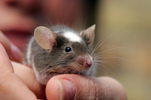
Keeping Mice as Pets – Small Creatures, Big Personalities
, by Majella Gee, 18 min reading time

, by Majella Gee, 18 min reading time
Let’s be honest — mice have copped an unfair reputation. Somewhere along the line, humans decided they belonged in traps rather than our hearts. But the truth? Mice make fantastic little companions. They’re intelligent, social, curious, and full of personality.
The problem is, most of what you’ll read about caring for them is outdated, oversimplified, or flat-out wrong.
If you want to do right by your mice — whether you’re just starting out or have had them for years — this is the real talk version of how to care for them naturally, safely, and with respect for the tiny lives in your hands.

Housing – Think Bigger Than the Pet Shop Cages
Let’s start with this: most cages sold for mice are too small. Period. If a box says “suitable for two mice,” it’s probably barely suitable for one.
Mice need space to climb, dig, and play — a minimum of 60 cm x 40 cm floor space for a pair, but honestly, the bigger, the better.
Go for a tank or large wire enclosure with multiple levels — just make sure the flooring between levels is solid (no wire). Wire floors cause pressure sores and foot injuries.
Bedding: Choose natural materials like aspen shavings, hemp, shredded paper, or untreated wood pulp. Avoid pine and cedar — the aromatic oils irritate their respiratory systems.
Cleaning: Don’t overdo it. A full clean every week or two is plenty. Mice rely on scent trails for comfort and navigation. A squeaky-clean cage every few days just makes them anxious.
Company & Sexing – No Surprise Litters, Thanks
Mice are highly social animals and do best with company — but only if it’s the right company.
If you’re new to keeping mice, stick with females. They’re gentler, cleaner, and far less likely to brawl.
Sexing Tip: Males have a clear gap between the anus and genital opening, while females don’t. If you’re unsure, get a vet or experienced breeder to double-check — one mistake can lead to a dozen tiny surprises in just a few weeks.

Life Span – Tiny Lives, Big Impact
Mice don’t live long — usually 1.5 to 2 years, sometimes a little more if they’re well cared for and fed naturally. It’s short, yes, but they pack a whole lot of personality into that time.
Because their lives are brief, every day matters. They grow fast, mature fast, and sadly, age fast too. So give them the best you can — real food, safe housing, enrichment, and affection. You’ll be surprised how much connection you can build with something so small.

Cheese Myth Busted
Let’s clear this up once and for all — mice don’t actually like cheese.
That classic cartoon image of a mouse stealing a wedge of cheddar? Total myth. Cheese is too fatty, too salty, and not something they’d ever eat in the wild.
If you offer it, most mice will sniff it and walk away (unless they’re desperate). Stick to natural, wholesome foods instead — they’ll thank you for it.

Food – Fresh, Natural, and Pesticide-Free
Those bright “muesli-style” seed mixes look tempting, but most are loaded with pesticide-treated grains, sugar, and cheap fillers. Mice have tiny bodies — and those toxins hit harder.
Think of feeding mice like feeding yourself on a miniature scale: fresh, natural, and varied.
✅ Good foods:
❌ Avoid:
💡 Seasonal feeding: In cooler months, mice need more carbs and protein for warmth. In summer, lean toward fresh greens and juicy foods for hydration. Rotate foods to keep it balanced.
How Much to Feed
Mice are small, which means small tummies. A tablespoon of mixed food per mouse per day is plenty — plus a few fresh extras (a tiny slice of veg or fruit).
Overfeeding leads to obesity, liver strain, and short lifespans. Remember, they store food naturally — so if you see piles tucked away, cut back a bit.

Water & Dishes
Always provide fresh, filtered water in a glass bottle (plastic harbours bacteria). Wash it every few days. Ceramic food dishes are best — they’re stable, hygienic, and can’t be chewed or tipped over.
The Mini Mouse Gymnasium
Mice are active little athletes. They love to run, climb, balance, and explore — and without enrichment, they get bored fast.
Create a miniature gym with:
Rotate items weekly to keep their environment fresh and exciting. You’ll notice the difference — happy mice are active, bright-eyed, and busy.

Natural Remedies & Enrichment Tips
Nature has a remedy for almost everything, even in a mouse cage.
Skip chemical sprays, perfumed bedding, and cage “deodorisers.” Vinegar and hot water are all you need for cleaning.

Final Thoughts
Keeping mice isn’t about having a novelty pet in a plastic box. It’s about respecting a small, intelligent life — one that depends on you to create a safe, stimulating, toxin-free world.
They’re not “starter pets” or children’s toys. They’re living, feeling beings that deserve proper care, good food, and freedom to express natural behaviour.
Give them that, and you’ll be rewarded with endless entertainment, affection, and the gentle reminder that even the tiniest creatures deserve our biggest compassion.
©Majella Gee 2025
#miceaspets #naturalmousecare #majellaspetstore #smallpetcare #responsiblepetownership #holisticpetcare #naturalpetcare #petwellbeing #toxinfreepets #ethicalpetcare #peteducation #ecofriendlypets #mousefacts #mouselove #petmice #pocketpets #smallanimals #petnutrition